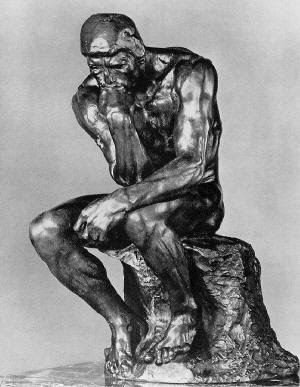Here am I, preparing for my first proper shoot of the project: Adam and Eve.
I have started at the very beginning, because it seemed like a good place to start.
First, I had to search for my own visions of Adam and Eve. I trawled through all my memories and dreams until I came to it. I can't remember whether it was in Rome or Venice, but I recall two very tall, very white marble statues, in a courtyard, covered in ivy, which had scaled their plinths and draped it's trailing fingers across the nude bodies. I remember that Adam and Eve looked distinctly similar, I was unable to tell them apart for quite some time. I do not know whether that was how they were intended, or if they had just been weathered down by the winds and the acidic italian rain.
In more recent year, neither I or my parents could remember who had crafted those impressive statues, but I think I have limited it down to Rodin. Of course it could be just another unknown who plagarised his sellout style, but Rodin seemed like a good place to start.
RODIN
Sculpturally, Rodin possessed a unique ability to model a complex, turbulent, deeply pocketed surface in clay. Many of his most notable sculptures were roundly criticized during his lifetime. They clashed with the predominant figure sculpture tradition, in which works were decorative, formulaic, or highly thematic. Rodin's most original work departed from traditional themes of mythology and allegory, modeled the human body with realism, and celebrated individual character and physicality. Rodin was sensitive of the controversy surrounding his work, but refused to change his style. Successive works brought increasing favor from the government and the artistic community.
From the unexpected realism of his first major figure—inspired by his 1875 trip to Italy—to the unconventional memorials whose commissions he later sought, Rodin's reputation grew, such that he became the preeminent French sculptor of his time. By 1900, he was a world-renowned artist. Wealthy private clients sought Rodin's work after his World's Fair exhibit, and he kept company with a variety of high-profile intellectuals and artists. He married his life-long companion, Rose Beuret, in the last year of both their lives. His sculpture suffered a decline in popularity after his death in 1917, but within a few decades his legacy solidified. Rodin remains one of the few sculptors widely known outside the visual arts community.



LEOCHARES
Leochares worked at the construction of the Mausoleum of Maussollos at Halicarnassus, one of the "Seven Wonders of the Ancient World". The Diana of Versailles is a Roman copy of his original (circa 325 BC). He is also thought to be the creator of the celebrated Apollo Belvedere, of which a Roman copy is currently housed in Vatican City.
Of his portrait-statues, the most celebrated were those of Philip, Alexander, Amyntas III, Olympias, and Eurydice I, which were made of ivory and gold, and were placed in the Philippeion a circular building in the Altis at Olympia, erected by Philip II of Macedon in celebration of his victory at Battle of Chaeronea (338 BC)





No comments:
Post a Comment